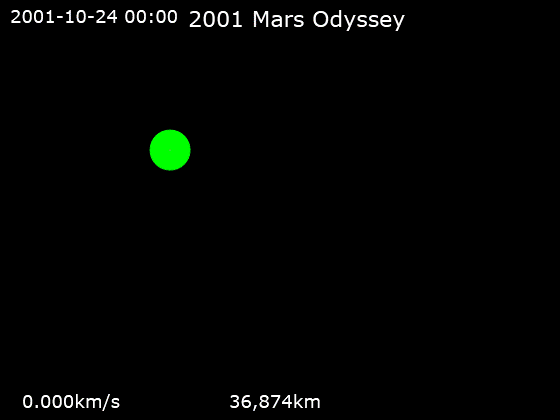|
2001 Mars Odyssey
''2001 Mars Odyssey'' is a robotic spacecraft orbiting the planet Mars. The project was developed by NASA, and contracted out to Lockheed Martin, with an expected cost for the entire mission of US$297 million. Its mission is to use spectrometers and a thermal imager to detect evidence of past or present water and ice, as well as study the planet's geology and radiation environment. The data ''Odyssey'' obtains is intended to help answer the question of whether life once existed on Mars and create a risk-assessment of the radiation that future astronauts on Mars might experience. It also acts as a relay for communications between the ''Curiosity'' rover, and previously the Mars Exploration Rovers and ''Phoenix'' lander, to Earth. The mission was named as a tribute to Arthur C. Clarke, evoking the name of his and Stanley Kubrick's 1968 film '' 2001: A Space Odyssey''. ''Odyssey'' was launched April 7, 2001, on a Delta II rocket from Cape Canaveral Air Force Station, and ... [...More Info...] [...Related Items...] OR: [Wikipedia] [Google] [Baidu] |
Areocentric Orbit
An areocentric orbit is an orbit around the planet Mars. The ''areo-'' prefix is derived from Ares, the Greek equivalent of the Roman god Mars. The name is analogous to the term geocentric orbit for an orbit around Earth and heliocentric orbit for an orbit around the Sun. As with these other orbits, the apsides of an areocentric orbit are sometimes called by specialized names: the pericenter is named periareon (analogous to perigee) and the apocenter is named apoareon (analogous to apogee). The first artificial satellite to orbit another planet — the U.S. probe ''Mariner 9'' — entered areocentric orbit on 13 November 1971. Within a month, Mariner 9 was joined in orbit by two Soviet orbiters: ''Mars 2'' (27 November 1971) and ''Mars 3'' (2 December 1971). See also * Areostationary orbit *Heliocentrism *List of orbits This is a list of types of gravitational orbit classified by various characteristics. Common abbreviations List of abbreviations of common Earth orbit ... [...More Info...] [...Related Items...] OR: [Wikipedia] [Google] [Baidu] |
Mars
Mars is the fourth planet from the Sun. It is also known as the "Red Planet", because of its orange-red appearance. Mars is a desert-like rocky planet with a tenuous carbon dioxide () atmosphere. At the average surface level the atmospheric pressure is a few thousandths of Earth's, atmospheric temperature ranges from and cosmic radiation is high. Mars retains some water, in the ground as well as thinly in the atmosphere, forming cirrus clouds, frost, larger polar regions of permafrost and ice caps (with seasonal snow), but no liquid surface water. Its surface gravity is roughly a third of Earth's or double that of the Moon. It is half as wide as Earth or twice the Moon, with a diameter of , and has a surface area the size of all the dry land of Earth. Fine dust is prevalent across the surface and the atmosphere, being picked up and spread at the low Martian gravity even by the weak wind of the tenuous atmosphere. The terrain of Mars roughly follows a north-south ... [...More Info...] [...Related Items...] OR: [Wikipedia] [Google] [Baidu] |
Orbit
In celestial mechanics, an orbit (also known as orbital revolution) is the curved trajectory of an object such as the trajectory of a planet around a star, or of a natural satellite around a planet, or of an artificial satellite around an object or position in space such as a planet, moon, asteroid, or Lagrange point. Normally, orbit refers to a regularly repeating trajectory, although it may also refer to a non-repeating trajectory. To a close approximation, planets and satellites follow elliptic orbits, with the center of mass being orbited at a focal point of the ellipse, as described by Kepler's laws of planetary motion. For most situations, orbital motion is adequately approximated by Newtonian mechanics, which explains gravity as a force obeying an inverse-square law. However, Albert Einstein's general theory of relativity, which accounts for gravity as due to curvature of spacetime, with orbits following geodesics, provides a more accurate calculation and u ... [...More Info...] [...Related Items...] OR: [Wikipedia] [Google] [Baidu] |
A Space Odyssey (film)
''2001: A Space Odyssey'' is a 1968 Epic film, epic science fiction film produced and directed by Stanley Kubrick. The screenplay was written by Kubrick and Arthur C. Clarke. Its plot was inspired by several short stories Option (filmmaking), optioned from Clarke, primarily "The Sentinel (short story), The Sentinel" (1951) and "Encounter in the Dawn" (1953). The film stars Keir Dullea, Gary Lockwood, William Sylvester, and Douglas Rain. It follows a voyage by astronauts, scientists, and the sentient supercomputer HAL 9000 to Jupiter to investigate an Monolith (Space Odyssey), alien monolith. The film is noted for its scientifically accurate depiction of spaceflight, pioneering special effects, and ambiguous themes. Kubrick avoided conventional cinematic and narrative techniques; dialogue is used sparingly, and long sequences are accompanied only by music. Shunning the convention that major film productions should feature original music, ''2001: A Space Odyssey'' takes for 2001 ... [...More Info...] [...Related Items...] OR: [Wikipedia] [Google] [Baidu] |



